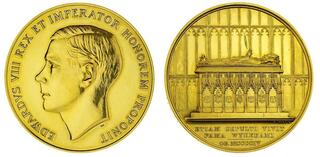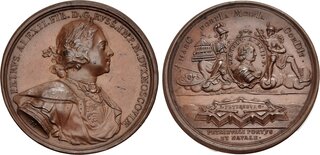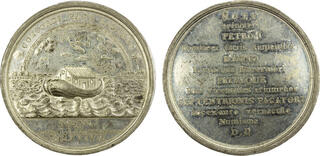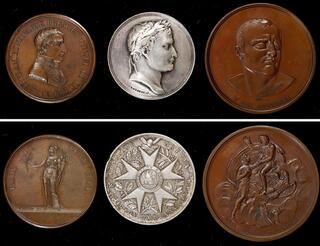Lot description:
Edward VIII (1936), Winchester College, The King's Gold Prize Medal, 1936, awarded to Christopher Ivan William Seton-Watson MC*, by Thomas Humphrey Paget and Bertram Wyon, EDWARDVS VIII REX ET IMPERATOR HONOREM PROPONIT, 'classical' bare head left, rev. the tomb of William of Wykeham, ETIAM SEPULTI VIVIT FAMA WYKEHAMI OB MCCCCIV in three lines in exergue [\Even buried the fame of Wykeham lives, died 1404"], 49mm., 86.35g., [Unhallmarked, Spink XRF: 18ct. Gold, London (Royal Mint)], struck retrospectively on 2 March 1937, edge largely plain but inscribed upwards C. I. W. SETON-WATSON. 1936. in New Roman capitalised script 9 and 4 o'clock (BHM - [cf. 4383/3720]; Eimer - [cf. 1240]; Jeremy Cheek, 'Royal Prize Medals', BNJ, 2018, pp. 175-188), faintly hairlined and lightly wiped in otherwise lustrous, original fields, an unfortunate but largely imperceptible scratch above Wykeham, otherwise extremely fine and much as issued, OF NATIONAL SIGNIFICANCE, as a 'one-year type' of which only two examples were struck off in gold for English and Latin Speech at Winchester College, the oldest continuously operating patron of an annual Royal Prize Medal, and whose unique obverse legend: 'Edward VIII, The King and Emperor Proposes this Honour' elevates this prestigious award to truly exalted numismatic heights especially when viewed alongside the approved 'Coin Portrait' in a format larger even than his legendary Pattern Five-Pounds, and critically struck in gold, by and housed in, the Royal Mint official case of issue with the stunning and seldom-encountered Edward VIII Cypher in gold-letter
Provenance
The Estate of Christopher Ivan William Seton-Watson MC and Bar (1918-2007).
Christopher was born 6 August 1918, the younger son of Robert William and Marion Esther Seton-Watson. He was baptised at St Margaret's (Westminster) on 7 October that same year. Prior to education, he resided at No. 1 Buckingham Street, Buckingham Gate, London. His father, often writing under the pseudonym 'Scotus Viator' from here, proved a troublesome thorn in the side of the British Government for his outspoken beliefs on a federal solution to Austro-Hungary. Conscripted into the Royal Army Medical Corps in 1917, his allies soon rescued him to the Intelligence Bureau of the War Cabinet and the Enemy Propaganda Department. It was during this posting that Marion would fall pregnant and Christopher would be born.
Whilst his second son was still an infant, Robert journeyed to Paris on his own diplomatic mission for the Peace Conference of July 1919. He continued to rile European officials with his jibe about the 'pygmies of Paris', but equally sought the renewal of friendships with ministers of the new state of Czechoslovakia. His allies Tomáš Masaryk would become the first premier; and Edvard Beneš its Foreign Minister. Unsurprisingly Seton-Watson Senior would prove instrumental in the establishing the post-war frontiers of Yugoslavia and Italy.
Robert separately established the School of Slavonic Studies and from 1922 held its post as the first Masaryk Chair of the Faculty. Following the Wall Street Crash of 1929, Robert devoted his time to academic teachings; although was reportedly unpunctual, untidy, and too preoccupied with other matters". Unsurprisingly, Prime Minister Neville Chamberlain's later policy of appeasement to Nazi Germany about the subject of Czechoslovakia, found in Seton-Watson one of his governments most pointed critics. This lead to his publication of "Britain in Europe: 1789-1914 - A Survey of Foreign Policy, 1937, in which he argued for the strengthening of the enforcement role of the League of Nations as a 'united European front against the disturbers of the peace'; in short to be an active deterrent against the 'inverted Bolshevism of Italy' and naked aggression of Germany. Following the Second World War, Seton-Watson lamented the loss of the former Easter blocs new-found democratic freedoms, retiring to the Isle of Skye where he died in 1951.
With the pursuit of geo-political and military history firmly embedded within the traditions of this family, it is unsurprising to see first Hugh (born 1916), and then Christopher follow in their father's footsteps. Educated at Horris Hill, Christopher became a scholar of Winchester College in 1931. In the Summer of 1936, Christopher would receive this prestigous King's Gold Prize Medal for Latin Verse; and subsequently serve as Head Boy, or 'Aule Prae' until he left the school the following year. His academic record was excellent - having further distinguished himself in History and Latin Speech; a School Exhibition; and as the recipient of the main Classical Prize for an Old Wykehamist - the Goddard Scholarship.
The following year, Christopher commenced his Bachelor degree at New College, Oxford with the study of Classics and PPE, and helpfully where his elder brother Hugh was already working as a lecturer. Also revealed on the 1939 Census is the fact Christopher had joined the Officer Training Corps as a Cadet. This would expedite his transition into the colours upon the outbreak of hostilies in September 1939.
The history of the Winchester College Prize Medal dates to at least as early as the first decade of the reign of King George III in the 1760s. However, it was not until 1797, that the Prince of Wales (the then Prince Regent) took up the patronage of the award and the addition of HONOREM PROPONIT ("Proposes the Honour") was made to the design. This Royal Prize Medal is the oldest of the now 24 annual awards bestowed by the Sovereign across the Armed Forces, Education, Architecture, Science, Poetry and Geography. As noted by Christopher Eimer (Author, British Historical Medals): "the medal was established by the Prince of Wales... two each in gold and silver, to be awarded in gold for Latin speech and in silver for Latin prose; the other two medals to be awarded for English, gold for speech, silver for verse, these to be awarded in alternate years." Today, Winchester College preserves an early example of the award for 1801, stating the transitional legend 'HONOREM PRINCEPS PROPONIT' and the device of the Prince of Wales (the Ostrich Feathers). When the Prince Regent became King George IV in January 1820, the bestowal of the Prize Medal became the preserve of the Sovereign, a tradition that endures to the present day over two centuries later. The present design was updated by Bertram Wyon during the reign of Queen Victoria to depict the tomb of school founder William of Wykeham, who died in 1404.
Winchester College also preserves a small collection of prize medals from the reign of King George V (1919); King George VI (1945) and the late Queen Elizabeth II (2008).
As Cheek notes: "Laurence Brown went to great lengths to define which medals should or should not be included in his book. Generally prize medals were excluded, as he felt that if he did not do so the book would never be complete or be published. However his overriding consideration was that medals of national importance would be included. As Royal Prize Medals were thought to be of national importance they were there confusingly in both categories. The result was that Royal Prize Medals issued during the reigns of George IV (1820-30) to George VI (1936-52) were included in BHM....
He continues: "There are also other Royal Price Medals not listed in BHM and not present in the following set: those medals produced with the effigy of Edward VIII, of which twenty-six were produced late in 1937. Equivalent issues to nos. 1-7, 10-12, 14-16, 18 and 20-21 were produced bearing the effigy of Edward VIII; no Edward VIII medals were produced for the Royal Geographical Society (Founder's Medal); the Royal Institute of British Architects, the Police Essay Competition or the Poetry Medal. A Royal Household Long and Faithful Service medal of Edward VIII was produced but never awarded; there is an example in the Royal Mint Museum. The other medals listed in the set described below were only initiated after the abdication of Edward VIII in December 1936.
Laurence Brown was an assiduous researcher and I am sure that the omission of these medals from BHM was deliberate, presumably because he believed that they should be considered as Patterns for medals that were not issued, and thus lay outside the scope of his book. However since the publication of BHM two examples of Royal Prize Medals with the effigy of Edward VIII have appeared at auction inscribed with receipients' names, so it would appear that at least two were in fact awarded. There are no specimens of Royal Prize Medals with the effigy of Edward VIII in the Royal Collection."
Corpus:
1. Royal Military Academy (Sandhurst)
2. Britannia Royal Naval College (Dartmouth); Awarded to Peter S Wilson; Morton & Eden, Auction 8, 25 May 2004, lot 133 (£6,200 HP); Joseph S Giordano Collection
3. Royal Air Force College (Cranwell)
4. King Edward VIII School (King's Lynn)
The abdication of King Edward VIII on the 11 December 1936 brought to an end a tumultous 325-day reign. The termination of his reign brought with it the logistical headache of scrapping his approved effigy for a replacement in the likeness of King George VI. Deputy-Master of the Royal Mint (1922-1938), Sir Robert Arthur Johnson conceded: "The work of the two artists was all but completed when the events of last December rendered it nugatory. Over 200 dies of coins, medals and seals were thus rendered useless and the Mint was faced with the task of securing portraits of his present Majesty with but limited time available." He added in the same December 1937 interview shortly before his death: "I am betraying no profound secret in stating that the coinage effigy of the former King was, at his personal wish, prepared facing to the left. But as there has been no coinage bearing the bust of the former King, the old tradition has maintained by showing the effigy of the present monarch facing in the same direction as the last monarch but one. The new King's effigy faces left, as did those of King George V and Queen Victoria, a fact which is surely one of the most happy augury."
He concluded: "During 1936, in the early stages when the coinage for King Edward was in question, I was made aware that some desire existed for a complete departure from the heraldic tradition which has been associated for several centuries with our principal coins."
Based on surviving Royal Mint Archives, Official Gazette entries, contemporary newspaper reports and eyewitness accounts, the following timeline can be reconstructed for the numismatic and philatelic record of the short-lived King's reign.
20 January 1936 - At five minutes to midnight, King George V dies at Sandringham and his eldest son David, Prince of Wales becomes King Edward VIII.
Thursday, 6 February 1936 - An official at the General Post Office informs the Daily Telegraph, that: "New postage stamps and postal orders bearing the portrait of King Edward VIII are not likely to be issued until the end of the year. It can also be authoritatively stated that no mourning stamps are to be printed. The annual sale of stamps in Britain totals 7,000,000,000. Postal orders number 225,000,000. Of the 70,000 letter boxes in the country, comparatively few will bear King Edward's initials for some time. New boxes will do so. Letter boxes bearing the inscription E.R. VII are still in existence, and there are still a few old ones marked V.R. On the 9,000 mail vans, the Royal initials will be altered as the vehicles are repainted." It is estimated that only 271 post-boxes bearing the cypher of Edward VIII were eventually produced. The same day, the 4th Winter Olympiad is opened in Garmisch-Partenkirchen by Adolf Hitler.
Friday, 21 February 1936 - "The King received Sir Robert Johnson, Deputy Master of the Royal Mint at Buckingham Palace, and inspected a plaster cast of his own head, which had been prepared at the Mint. The cast will, with Royal Approval, be used not only for the new coins, but also in the preparation of dies for medals and other purposes."
Friday, 13 March 1936 - "The King has approved two designs for the new Royal cypher: "E.R. VIII.". The War Office will make known to the public next week the designs submitted by Garter King of Arms which have been approved by the King. One Cypher in plain modern block letters surmounted by the Imperial Crown, will be used by the postal authorities and Government offices, Embassies, Legations and Consulates abroad, and by Dominions, India and the Crown Colonies. The other cypher follows the traditional style of interlocked initials with oak-leaf fringes. This will be used by the armed forces and the constabulary of the Empire."
Tuesday, 28 April 1936 - The King sat at Buckingham Palace for the two medallionists [Thomas Humphrey Paget and Percy Metcalfe] of the Royal Mint, for the head which will appear on the new coinage and the medals which will be granted by King Edward the Eighth.
Friday, 1 May 1936 - In what is estimated to be a £1,000,000 stimulus to the manufacting and stationery industry of Britain, the first printed examples of the King's Cypher appear in circulation.
Saturday, 30 May 1936 - Bradford Post Office becomes the first building in Britain to feature the King's new cypher.
Monday, 20 July 1936 - The Annual Swan Voyage of His Swan Master's Skiff along the River Thames exhibits the new Royal Cypher 'in red surmounted by a gold crown'.
Friday 31 July 1936 - Sir William Currie, Chairman of the Worcester Committee announced that the King had been graciously pleased to become the patron of [Thames Nautical College, H.M.S.] Worcester. The King's gold medal was won by Kenneth Hodson. "A letter from the Secretary of the King's Privy Purse was read explaining that the medal could not be presented yet as a new one had to be cast bearing King Edward's head." This same medal was later sold by Sotheby's at an auction of 5 July 1994 (lot 211) and is believed to remain in a Private British Collection.
Friday, 7 August 1936 - The King approves the uncrowned effigy submitted by Mr Thomas Humphrey Paget for his coins and medals, and the designs for the reverse of the new silver coinage by Mr George Kruger Gray.
Tuesday, 1 September 1936 - Edward VIII's uncrowned effigy is released on stamps at midnight, featuring the series of halfpenny, threehalfpenny and twopence-halfpenny. London's three 'all-night post offices' in Fleet Street were besieged by collectors with queues forming two hours beforehand. "The issue was regarded as the greatest success of any recorded by the Post Office as over 30,000,000 stamps were sold on the first day." The following day however, critics were quick to note: "The head of the King is far from being the best photograph that has ever been taken and makes him appear more youthful than he really is. People are asking why there could not have been a break from tradition. Why always a face in profile? Why not full face, with the King wearing that boyish smile which has endeared him to millions? The new Australian stamp shows the King full face, so why not the English?" The Belfast Newsletter notes: "People are expressing the hope that a little more imagination will be displayed in the preparation of the new King Edward coins than has been manifested in the printing of the new stamps."
Monday, 14 September 1936 - The penny stamp of Edward VIII is released.
Wednesday, 16 September 1936 - The Royal Mint submits proposals to the Treasury for a new larger Threepence coin. An official stated: "the size is midway between that of a sixpence and a shilling. Efforts are being made to find a distinctive edge for the coin. The metal to be used has not yet been decided upon. The new coin will not however be made of silver or nickel." As Prince of Wales, Edward had described the silver issue, colloquially dubbed a 'joey' as an 'annoying coin'.
Monday, 8 December 1936 - The Official Gazette, Notice No. 769 states: His Majesty the King has approved the issue of the customary official medal to commemorate His Majesty's Coronation. The medal will show on the obverse the crowned effigy of His Majesty with legend, and on the reverse the gateway of St James's Palace. "The Royal Mint are prepared to accept orders for these medals in Gold, large size, diameter 2.5 inches, price 50 guineas; small size, diameter 1.25 inches, price 12 guineas." Notice No. 770, states: "It has been announced that His Majesty the King will broadcast a message to the Empire on the day of his Coronation, Wednesday 12 May 1937. This will be His Majesty's first act after the Coronation ceremony is over. It is understood that a message to the Empire will not be broadcast by His Majesty at Christmas."
Wednesday, 10 December 1936 - King Edward VIII signs his 'Instrument of Abdication'
Thursday, 11 December 1936 - King George VI acceeds to the throne
Tuesday, 2 March 1937 - The Royal Mint produces the obverse die hub for the Winchester College, King's Prize Medal. As each Royal Award is the preserve of the incumbent Sovereign, it is elected to retrospectively strike the medals with the 'classical' uncrowned effigy of the former King Edward VIII for those awarded in 1936. These are distributed to recipients over the following month.
i) The Royal Collection boasts the artist's approval in gilt metal of King George VI sent for the monarch's personal assent (RCIN 443736). No artistic trials of Edward VIII were produced for the same purpose as the medals were to be produced retrospectively.
ii) Spink has offered Marcus William Dick's, 1938 award in 2014, lot 628
iii) Spink has offered John Christopher Dancy's, 1939 award in 2021, lot 8110
Estimate: 15000 - 20000 USD |  |












